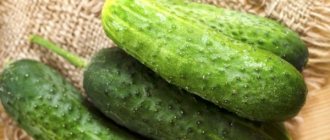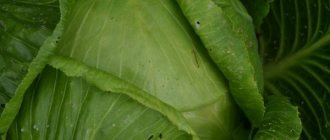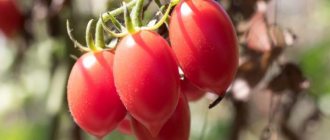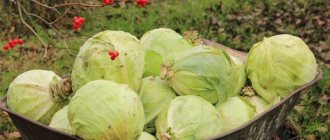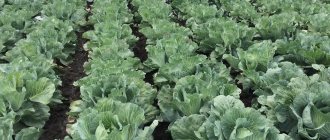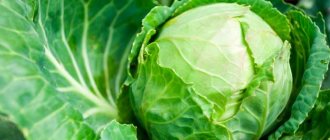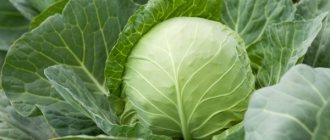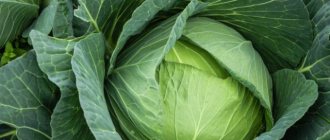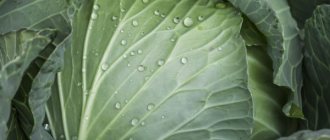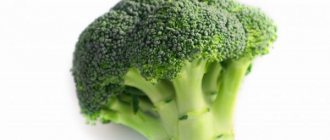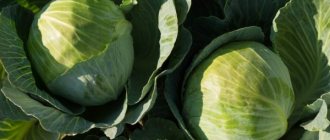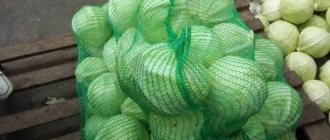Cabbage Crumont F1 is a hybrid variety that is worth paying attention to when choosing which white cabbage to grow to stock up on for the winter. Immediately after harvesting, it will not be possible to make a salad from it; the leaves are slightly bitter, but after storage, the bitterness goes away and the taste reveals itself in all its glory.
| Landing location | Ripening time | View | Purpose | Origin | Maturation period | Weight |
| Open ground | Late ripening | White cabbage | Long-term storage, fermentation, cooking | Hybrid | 165-170 | 1,9-4 |
Description of Crumont cabbage
Important parameters when choosing a cabbage variety are ripening time, yield and taste characteristics. Hybrid Krumont F1 meets the highest requirements of vegetable growers. It was developed by Russian scientists from the Timiryazev Agricultural Academy and has been on the State Register since 1992. The unique variety is allowed to be grown in all territories of the Russian Federation, except for the North-Eastern and Northern regions.
The density and alignment of the heads give the variety commercial value
Main parameters:
- Ripening period is late. From the first shoots to harvesting, 165-170 days pass.
- The socket is semi-raised, very compact. Height from 45 cm to 60 cm, diameter from 60 cm to 75 cm, number of leaves from 25 to 32 pcs.
- The head of cabbage is medium in size and very dense. The shape is leveled, rounded-flat or rounded. Crumont heads are resistant to cracking, smooth and morphologically even. The color of the outer leaves is dark green, with a pronounced shade of gray, while inside, when cut, it is almost white. The weight of one head of cabbage ranges from 1.9 kg to 2.2 kg. In the southern regions, vegetable growers remove 4 kg heads.
- Cabbage leaf blades are smooth, the edges are wavy-toothed. The lower leaves have a petiole 6 cm long. The venation of the leaf resembles the shape of a half-fan. Leaves length 55 cm, width about 40 cm.
- The outer stump is medium in size - from 18 cm to 23 cm. The inner stump is thin and much shorter (up to 10 cm).
A very important characteristic is the ability of the Crumont variety to be collected and processed by mechanization. Another factor is stability during transportation and excellent shelf life.
Detailed description of the qualities of the Krautman F1 hybrid
A popular, high-yielding hybrid of white cabbage with excellent taste and appearance, loved by many gardeners and farmers - all this is Krautman F1 cabbage. Its description is based only on a list of advantages, since this cabbage has practically no disadvantages.
The hybrid is included in the State Register for many regions of Russia, Ukraine and Moldova. It is grown even in the Far East and East Siberian regions. It is the best in all indicators in the mid-late group of cabbage of Dutch selection.
When growing Krautman F1 you can always count on a full harvest. You just need to follow the basic norms and rules of crop care. You can get vegetable products already 120-140 days after the first shoots.
Description
The leaf rosette of Krautman F1 cabbage is raised and compact. The leaves are medium in size. They have a rich waxy coating and green color. There is wrinkling on the leaves. The edges are smooth and even.
A ripe head of cabbage has a round shape. It is dense, with a thin internal structure, semi-closed. The weight of individual specimens can be from 1.5 to 4 kg. When cut, the head of cabbage is snow-white. The outer and inner stalks are the same length, medium size. The forks are level and resistant to cracking.
The white cabbage hybrid Aggressor is a mid-late crop. It stores well and gives an excellent harvest. Read more…
The purpose of cabbage is to use it fresh, canning, pickling and pickling.
Subject to simple conditions and growing rules, from each square. m you can harvest up to 9 kg of crop.
You can store collected vegetables for up to 4 months. During this time, they do not lose their taste and presentation.
Advantages and disadvantages
Krautman's description of cabbage implies a listing of all the positive and negative qualities of the product.
Compared to other varieties of mid-season white cabbage, the hybrid has its advantages:
- The main advantage of Krautman F1 cabbage is considered to be its high content of vitamins A and C, minerals and nutrients. According to these indicators, the variety is superior to cauliflower.
- Heads of cabbage can remain on the root for a long time without cracking. They are also not subject to rotting.
- The leaves of the hybrid are crispy and very juicy.
- The vegetable easily tolerates transportation.
- Krautman is not susceptible to diseases and is resistant to various pests. Even the keel is not afraid of him.
- Cabbage has excellent pickling qualities.
- The variety can be used for pickling. The product has a pleasant acidic taste.
- Friendly and timely delivery of the harvest simplifies the process of harvesting and preparing for storage.
- It is possible to achieve a high yield even in bad weather conditions and sudden temperature changes.
- Excellent external data allows you to successfully sell the product on the market.
Experienced vegetable growers note that the heads of cabbage of this variety are very dense, but the leaves are not coarse, but soft and juicy.
The hybrid is quite flexible. Gives good results in various regions. It can even withstand dense plantings.
The heads of cabbage of this hybrid are aligned in size, which is convenient for transportation. Such compact specimens are convenient to grow, collect and send for sale. They are in demand among consumers.
Among the disadvantages in the description of Krautman cabbage, one can note the short shelf life of collected vegetables (maximum 4-5 months). But all mid-season cabbage varieties cannot boast of this indicator.
The hybrid is also demanding on certain growing conditions. In order for a plant to form a powerful root system, it is necessary to carry out a number of actions: proper watering, hilling, loosening and weeding. Cabbage must be fed with mineral fertilizers. Provide a sunny, unshaded area that is well ventilated. Seedlings should not be allowed to be pulled out.
Sometimes there is a slight infection by mucous bacteriosis.
Secrets of cultivation
When growing Krautman F1 cabbage, the seedling method is used. Sowing seeds for seedlings can be done in early April. They should be deepened into the ground by 0.5-1 cm. Shoots may appear as early as 5-6 days. The plant needs to be planted in open ground at the end of May, usually on the 40-45th day. By this time, the seedlings have several true leaves. The best scheme for growing cabbage is 50×50. Before transferring seedlings to a permanent place, it is necessary to carry out hardening procedures. Leave plants outside during the day. The seedlings also need to be fed. Apply the first fertilizing when two leaves appear, the second immediately before planting.
Pros and cons of Crumont cabbage
To understand the advantages of a hybrid over other varieties of cabbage, you should group its advantages and note its disadvantages.
The advantages of Krumont F1 are:
- excellent taste;
- rich nutritional composition;
- alignment, compactness and density of heads;
- high immunity to diseases;
- ability for long-term storage (6-7 months);
- no cracking of fruits;
- versatility of use;
- the possibility of industrial cultivation and the use of harvesting equipment;
- ease of care.
Disadvantages of the variety:
- the presence of a bitter aftertaste, which disappears 2-3 months after harvesting from the field;
- small volume of heads for a late-ripening variety.
The first disadvantage is due to the biological specifics of the hybrid, but vegetable growers do not always consider it a disadvantage.
Secrets of cultivation
When growing Krautman F1 cabbage, the seedling method is used. Sowing seeds for seedlings can be done in early April. They should be deepened into the ground by 0.5-1 cm. Shoots may appear as early as 5-6 days. The plant needs to be planted in open ground at the end of May, usually on the 40-45th day. By this time, the seedlings have several true leaves.
The best scheme for growing cabbage is 50×50. Before transferring seedlings to a permanent place, it is necessary to carry out hardening procedures. Leave plants outside during the day. The seedlings also need to be fed. Apply the first fertilizing when two leaves appear, the second immediately before planting.
The variety produces a good harvest on loamy, fertile soils. Cabbage cannot be cultivated in the same areas for another 3 years. The best predecessors are legumes and pumpkins.
Planting and caring for Crumont cabbage
It is recommended to grow the variety in seedlings. In this case, late-ripening cabbage has time to form heads even in regions with a cool climate. Sowing seeds should begin in February in more southern areas and in April in the north.
The germination rate of cabbage is high (up to 90%). The first shoots appear within a week. Before germination, the room temperature should be within + 20-24 °C. Then the value is reduced to + 15-18 °C (daytime) and + 8-10 °C (nighttime). During the period before planting in open ground, you need to monitor the quality of watering and feed the seedlings once with a mineral complex.
Proper care of seedlings will allow you to obtain healthy planting material
The planting date for sowing is the end of April or the end of May. Seedlings should have 2-3 pairs of leaves. Planting pattern of the variety is 50 x 60 cm, depth 5 cm.
Crumont cabbage does not require special growing conditions. All events are standard:
- Watering. At least 1 time every 2-3 days for adult plants. Young seedlings need to be watered every day. Water – warm, volume of at least 3 liters per plant. The most abundant watering is needed in the head setting phase; before harvesting, it is stopped 14 days before the due date.
- Feeding. Two meals a day per season is enough. The first time you need to add organic matter 20 days after planting in open ground. 2 kg of humus per 1 square meter is enough. m, the second time you need minerals - superphosphate (20 mg), potassium nitrate (30 mg). They are diluted in 10 liters of water and 2 liters of solution are poured under each plant.
Fertilizing the Crumont variety is necessary to increase shelf life
- Weeding. Be sure to do this after watering or rain. It is necessary to remove all weeds so that they do not interfere with the development of cabbage seedlings.
- Hilling. Necessary to stimulate the growth of additional roots. The first hilling should be done 3 weeks after transplanting into open ground, the second – after 14 days.
- Loosening. This event allows you to increase the access of air and nutritional components to the cabbage root system. It is important to carry out the procedure for the first time after the seedlings have taken root, then once a week.
Important! The first loosening should be no deeper than 5 cm, repeated – up to 10 cm.
Characteristics of Kolobok cabbage
The hybrid cabbage variety “Kolobok f1” was created for cultivation in open areas; cultivation in closed structures is allowed. The culture is frost-resistant, does not stop growing at an air temperature of +180 C, and feels comfortable at the seedling stage at +160 C and medium light.
Attention! Vegetable crops do not require additional agrotechnical practices other than intensive watering and soil composition appropriate to the variety
Productivity and fruiting
The Kolobok cabbage variety, according to vegetable growers, is a high-yielding variety; with proper care (watering, fertilizing, preventing infections) it produces a stable harvest. The amount of fruiting and the size of the head of cabbage are not affected by differences in temperature between night and day. Vegetation does not stop with an excess of ultraviolet radiation or with its deficiency. The only condition is constant watering before sunrise and after sunset.
Cabbage “Kolobok” is a late variety; the forks reach biological maturity in the second half of October. The collection is carried out before the onset of frost. The culture is compact, does not grow in width, three plants are planted per 1 m2. The average weight of the fruit is 4 kg; if agricultural practices are followed, 12 kg are harvested from 1 m2.
Application of Kolobok cabbage
The Kolobok variety was created for industrial production. Due to its high yield, it is a favorite in farming areas. Cabbage is grown in home gardens and summer cottages. The fruits are universally used and can be stored for up to six months without losing their biological or taste value. Vegetables are well transported to retail outlets for sale and agro-industrial facilities for processing. Cabbage is suitable for pickling for the winter and is eaten fresh in salads.
Resistance to diseases and pests
During the period of experimental cultivation of the hybrid, its immunity was fully adapted to all kinds of infections. The variety is genetically resistant to: all types of rot, Alternaria blight, necrosis, fusarium blight. The cabbage cutworm poses a threat to the crop. The butterfly is capable of laying up to 2 thousand eggs. The caterpillars destroy the leaves, then the forks; if the cabbage is not treated, the entire crop will die. Slugs and aphids rarely parasitize the Kolobok cabbage variety.
Advantages and disadvantages of the variety
Mass cultivation of the plant in large volumes is the best indicator of the quality of the Kolobok variety cabbage. The undeniable advantages of vegetable crops:
- storage duration, at a temperature not exceeding +60 C in a well-ventilated, unlit area with minimal humidity. The variety lasts for more than six months;
- dense heads of cabbage are not prone to cracking;
- aesthetic presentation;
- good transportability;
- high-yielding cabbage "Kolobok" is a frost-resistant crop;
- has a good taste, due to the sufficient concentration of glucose there is no bitterness;
- resistant to diseases and most parasites.
A number of disadvantages are noted: the variety is demanding when it comes to watering, lack of moisture affects the density and weight of the fork, and the growing season is suspended. When planting in a permanent place, it is recommended to take into account the composition of the soil.
Advice! Suitable soils for normal vegetable growth are loamy with a slightly acidic reaction.
Soil with good water-holding capacity and a high concentration of organic matter is preferred.
Diseases and pests
The variety was bred with built-in resistance to common crop diseases. Crumont is not affected by clubroot, necrosis (during storage), fusarium, or bacteriosis. If you do preventive spraying, you won’t have to treat the cabbage. Parasites cause more trouble. Vegetable growers have to contend with butterflies, aphids and flea beetles. Copper-containing preparations, for example, Oxychom, work well against aphids. 50 mg of the substance per 10 liters of water is enough, then spray the cabbage after 10 days. The flea disappears after treatment with a solution of potassium permanganate (10 liters of water + 2 mg of powder). Colloidal salt (20 mg per 10 l) can be used against butterflies. Repeated spraying is needed every 7-10 days.
Parasites and diseases
The hybrid is resistant to common diseases - necrosis, bacteriosis, fusarium and even clubroot. For prevention, it is enough to regulate watering, do not overwater the cabbage, observe crop rotation and disinfect the soil before planting.
Common pests include butterflies, cruciferous flea beetles and aphids. Fungicides with copper, for example Oxyx, help against aphids. They also help in preventing fungi. The area is treated against fleas with a 2% solution of potassium permanganate, and against butterflies and their caterpillars - with a solution of colloidal salt.
Article rating:
Crumont f1 white cabbage package of 100 seeds description of the variety seeds Link to the main publication
Related publications
2 stolbur phytoplasmosis of tomatoes
Application
The Crumont variety contains carotene, vitamin C, and a good level of sugar (10%). Such components allow you to use the vegetable in any form - raw, pickled, salted, stewed. After the bitterness leaves the leaves, they are great for winter salads. The shelf life allows you to prepare vitamin dishes all winter.
Cabbage dishes nourish the body with beneficial vitamins and amino acids
Chinese cabbage (petsai)
Petsai is considered one of the healthiest types of cabbage. The plant forms an elongated head of cabbage from succulent leaves. During the season you can get 2 harvests.
Note to the gardener: How to properly plant Chinese cabbage in the ground
Pekinka is consumed mainly raw, but it is also suitable for preparing dishes and pickles. It contains a lot of vitamin C (27 mg/100 g), the concentration of vitamin A is higher than in other types. The chemical composition contains potassium, calcium, sodium, iron and other minerals. The calorie content is only 12 kcal/100 g - the dietary product is included in the diet of people trying to lose excess weight.
Related article:
The main reasons why cabbage does not set heads, and what to do about it
Petsai is recommended for use for heart disease, digestive problems, high blood pressure, and a tendency to swelling. Unlike many other members of the Brassica family, Pekin does not cause flatulence.
It is worth limiting the use of petsai in case of exacerbation of gastric diseases.
Popular varieties:
- Cha-cha;
- Russian size;
- Bilko F1;
- Ritchie F1;
- Nika;
- Hydra;
- Autumn jade.
White cabbage Three heroes
Late-ripening (145-160 days from germination to technical ripeness) variety. The heads of cabbage are round or flat-round, very large, up to 10-15 kg, do not crack, with juicy, tasty leaves and a small inner stump. The outer color is gray-green, there is a slight waxy coating, the color of the head of cabbage is white. One of the best varieties for pickling and long-term (6-8 months) storage. Sowing seedlings - in mid-March. Picking - in the cotyledon phase. Planting in the ground - in mid-May according to the 60x60 cm pattern.
Placing an order in standard mode looks like this: Fill out the form completely in successive stages: address, delivery method, payment method, personal information. We advise you to write information in the comments to your order that will help the courier find you. Click the "Place an order" button.
Online payment for your order
We include the necessary documents and receipts (delivery notes) in all parcels.
Delivery time is calculated from the moment the order is transferred to the delivery service in business days (on weekdays).
Delivery costs are calculated based on the total weight of the package (including the weight of packaging and marketing investments).
All online payments, with the exception of invoice payments, do not contain any commission for the buyer
When paying by credit card, you will be redirected to the YANDEX CASH payment gateway. The connection to the payment gateway and the transfer of information is carried out in a secure mode using the SSL encryption protocol. If your bank supports Verified By Visa or MasterCard SecureCode technology for secure online payments, you may also need to enter a special password to make a payment. This site supports 256-bit encryption. The confidentiality of the personal information provided is ensured by YANDEX CASH. The entered information will not be provided to third parties except in cases provided for by the legislation of the Russian Federation. Payments by bank cards are carried out in strict accordance with the requirements of the MIR and Visa Int payment systems. and MasterCard Europe Sprl.
Delivery by courier in Novosibirsk
| 10-12 days after the first application of fertilizing | Ash solution Urea (15 g per 10 l) |
| When forming and pouring forks | Superphosphate Agricola |
- The cost of delivery of small-sized goods in Novosibirsk is 300
rubles - The cost of delivery of large-sized goods in Novosibirsk is 600
rubles
Snow White
The late hybrid Snow White was bred by Ukrainian breeders. Here, scientists cross-pollinated such varieties and hybrids as Amager 611, Zimovka 1474, Denish Ballhead, Zimnyaya Gribovskaya 2176, Dauerweiss and, as a result, got Snow White. At first it was recommended for cultivation only in Ukraine and Kazakhstan. Currently, it is grown in the Central and Southern regions of the Russian Federation.
Hybrid characteristics
The full growing season of cabbage is 127 - 150 days.
Cabbage has a fairly powerful leaf rosette. Which in diameter can be from 70 cm. Its leaves are of medium size, which have a gray-green color. Also, there is a waxy coating. To the touch, the surface of the leaf is slightly wrinkled, while the edges of the leaf plate are smooth or wavy. The number of veins in the leaves is small.
Cabbage heads grow to sizes from 3 kg to 5 kg. When cut, you can see white flesh. Like most other late varieties, Snow White pleases us with good harvests.
The benefits of cabbage
- Frost resistance. Late cabbage varieties such as Snow White have enviable frost resistance. Even when the temperature drops to - 5 ° C - 10 ° C, the cabbage does not spoil (but it is better not to do this).
- The purpose is universal. Cabbage can be eaten fresh, pickled, pickled, and various dishes can be prepared from it.
- The heads turn out to be quite large and juicy, which means that the cabbage needs a lot of moisture.
- Resistant to cracking.
- Transportability. The heads of cabbage are dense, so they are not afraid of mechanical stress.
- Keeping quality. Cabbage can be stored for 6 - 8 months. But this is only subject to optimal conditions.
- Productivity. The cabbage harvest can be from 4.7 kg to 7.5 kg, and this is all from 1 sq. m plot. Although, the results may be better if you take better care of it (feeding, watering, crop rotation).
Disadvantages of cabbage
: This includes average disease resistance, as well as late ripening. Although, it depends on who.
Description and characteristics
Officially, this cabbage species is called Kolya F1, which indicates its hybrid origin. It was bred in the Netherlands by breeders from the seed production company Seminis Vegetable Seeds. The hybrid turned out to have consistently high yields and good tolerance to various climatic conditions, with the exception of severe frosts.
Did you know? The cabbage head is not a fruit at all, but a huge wintering bud sitting on a stem, the role of which is played by the stalk.
Taste and appearance
Hybrid cabbage Kolya F1 has excellent gastronomic qualities. Its taste is equally good both fresh and pickled or after heat treatment. A special feature of this variety is its complete absence of bitterness.
The cabbage head of this hybrid is different:
- round and slightly flattened shape;
- slight waviness of leaves;
- raised leaf rosette;
- weighing up to 8 kg;
- outer light green color;
- white on the cut;
- homogeneity of the internal structure;
- average size of the inner stalk.
Productivity and ripening time
Representing a mid-late white cabbage hybrid, Kolya F1 cabbage ripens within 130–135 days after planting seedlings in the open air. The yield of this cabbage averages 498 c/ha, reaching 652 c/ha under favorable conditions.
Find out how to choose the best cabbage variety to store for the winter.
Variety resistance
The hybrid does not have great frost resistance, but it has a strong immunity that protects it from:
- mucous bacteriosis;
- fusarium;
- vascular bacteriosis;
- thrips.
In addition, Kolya F1 has a very important quality for cabbage, which is the ability of the head of cabbage not to crack
